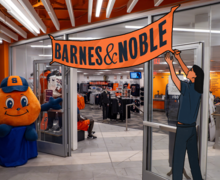Reconcilable differences: Tension between Syracuse Police Department and residents on Westside fades
Neighborhood Watch: Part 3 of 3
For many years, the relationship between the Syracuse Police Department and residents living in the city’s Near Westside has been one filled with tension and animosity.
But that relationship is slowly beginning to improve, said Maarten Jacobs, director of the Near Westside Initiative.
The recently released book, ‘I Witness: Perspectives on Policing in the Near Westside,’ details the tense relationship between police officers and residents, and it has been opening a dialogue between the two groups. Officers and residents have since been working on improving their relationship.
Jacobs said he thinks the strained relationship between police and Near Westside residents stems from a long history of mistrust.
‘There’s a whole gamut of feelings that residents have for police,’ Jacobs said. ‘Some love the police, some really trust them in their efforts, but then you have those who have had incidents where, too many times, the police didn’t show up for them, or they felt they were treated unfairly, and that’s where the strong sense of tension and mistrust comes from.’
The tension between the two groups also comes from the police department’s installation of surveillance cameras in the area approximately a year ago.
‘For a lot of residents, the cameras were discouraging,’ Jacobs said. ‘For them, it meant that everyone thought that this was the worst area in Syracuse, and it took away some of their sense of pride for their community.’
The cameras were set up specifically on the Near Westside because of the frequent gun and drug crimes that were occurring in the area, said SPD spokesman Sgt. Tom Connellan.
‘The cameras were put up to bring a sense of safety to the area,’ Connellan said. ‘They have been effective. Crime in the areas where the cameras were installed significantly decreased from 2010 to 2011.’
From 2010-11, arrest charges on the Near Westside decreased by 49 percent, overall reported crimes decreased by 29 percent and drug-related arrests decreased by 47 percent, according to data released by SPD officials.
Common Councilor Bob Dougherty said while he ardently supported the installation of the cameras to reduce crime rates, he recognized the frustrations it brought to the residents.
‘The cameras definitely brought added tension to the area,’ Dougherty said. ‘I know some Westside residents felt like they were being picked on and that their civil rights were being violated.’
Dougherty said though cameras introduced frustration, there was a general sense of approval for the effects it had on the neighborhood.
‘I think it really brought a new sense of safety to the residents living there,’ Dougherty said.
Jacobs, Near Westside Initiative director, said while the issue of the camera installations brought frustration to residents and police, it also brought about an outlet of discussion between the two groups.
‘The issue gave people an opportunity to voice their frustrations, and for many in the area, it was the first time they experienced police listening to the general public’s concerns and considering other solutions,’ Jacobs said.
Ben Kuebrich, editor of ‘I Witness,’ which was released in February, said the communication sparked by the camera controversy is exactly what police and Near Westside residents needed to mend their relationship.
The book’s purpose was to spark further dialogue and build trust between police and residents, Kuebrich said.
The book provides readers with perspectives from both Near Westside residents and police officers on the issue of neighborhood policing to create a mutual understanding between the different groups. Kuebrich said almost all police officers that patrol the Near Westside own a copy of the book.
‘The Westside is usually just represented by police reports and newspapers that report on the crime and poverty in the area, but there’s so much more to it,’ Kuebrich said. ‘The book was a way to let residents and police speak out about their experiences.’
Steve Parks, SU professor and board member of the Gifford Street Community Press, where Kuebrich’s book was published, said both police and residents have made progress in their relationship since the book was released.
Police and residents have held multiple face-to-face delegations to gain a better understanding of each other, Parks said.
The two groups have also held events such as brunches to invite further communication between each other. Additionally, SPD’s intramural baseball team, which consists of police officers, will lead a youth baseball clinic some time this summer, Parks said.
Jacobs said though progress has been made, there is still work to be done to improve the relationship between police and residents.
‘One of the things that I’d like to see is walking patrol officers in the neighborhood,’ Jacobs said. ‘All studies show that officers who patrol the neighborhood on foot and really get to know the residents have a much better relationship with them.’
Jacobs said the Near Westside Initiative office has proposed the idea to city officials in the past, but funding walking police patrol has proven to be too expensive. Jacobs said he hopes to find a way to fund the walking patrol in the near future.
‘The problem with building up this sort of relationship is that it takes time,’ Jacobs said. ‘It can get pretty frustrating on both sides to keep trying when progress can be slow, but a strong relationship between the two is really vital for the community.’
Published on April 18, 2012 at 12:00 pm
Contact Alexandra: adhitzle@syr.edu | @LexieHitzler





